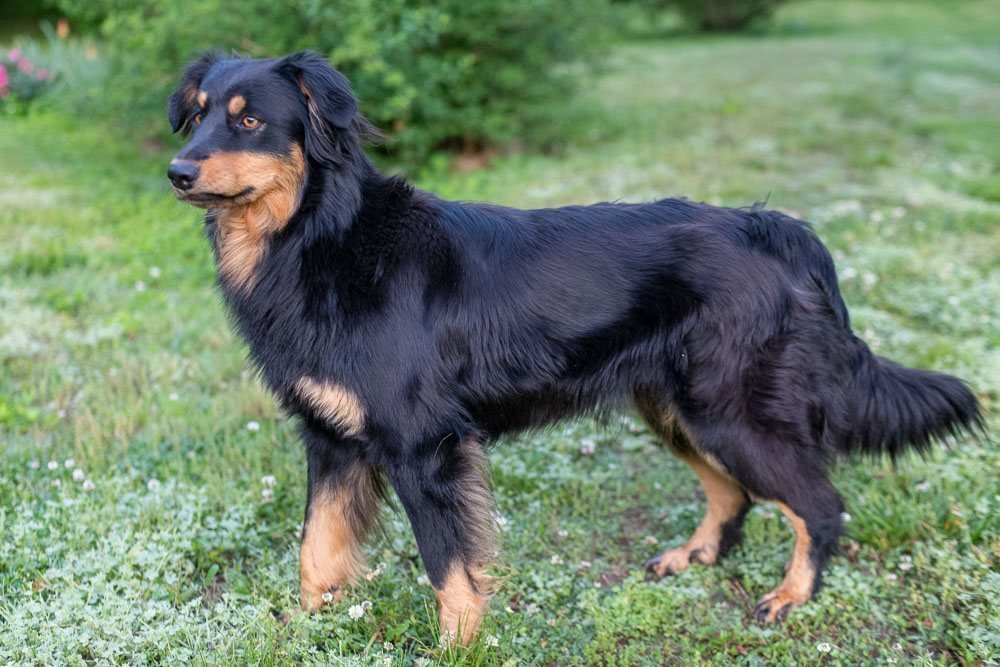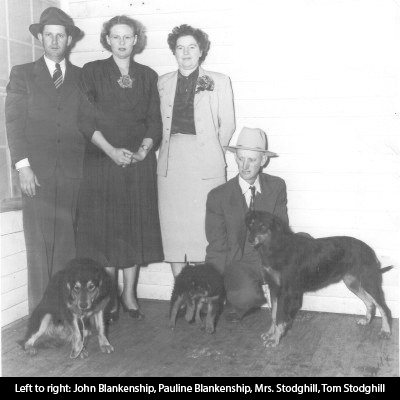A history of cultural use and appreciation
History
Historically, the old-fashioned Black and Tan English Shepherd dog was essential to the lives of many rural Tennesseans. But the utility of these all-purpose working dogs spread beyond the borders of Tennessee. In the Southeast, Black and Tan English Shepherds were well-known to farmers in Alabama, Mississippi, and Georgia. To the west, these gritty dogs were especially useful to cattle ranchers in Texas.[1]Guy Gordon, “How the English Shepherd Became a Cattle Herder,” The San Francisco Examiner, December 1, 1957 To the north, Black and Tan English Shepherd dogs earned a living on farmsteads throughout the Ohio river valley. And further east, these dogs were well-known to rural citizens of the Mid-Atlantic region. But the history and use of these farm dogs is particularly well-documented in Tennessee.
An All Purpose Farm Dog
On dairy farms, cattle ranches and rural family homes, the Black and Tan English Shepherd provided a variety of essential services. Horace Curtis of Algood, Tennessee writes about his black and tans from the early nineteen-hundreds. He tells of their ability to eradicate vermin, protect children, and drive cattle.[2]Horace Curtis, “A Match for Man or Beast,” English Shepherd Club of America’s Who’s Who Breeder Manual, pg 22 At about the same time, John Blankenship’s father rode into town on his old gray mare. Charles Blankenship of Wilson County kept a black and tan English Shepherd at his side to drive home the livestock he purchased.[3]John Blankenship, “The Blankenships’ Best Friend,” English Shepherd Club of America’s Who’s Who Breeder Manual, pg 19 Further east, Walter Oglivie of Allisona pushed his cattle through the thick woods of the Cumberland Mountains. He followed on horseback while a pair of black and tan English shepherds drove his stock over the narrow mountain paths. Upon reaching the rail head in Pikeville, Oglivie and his two dogs loaded the steers into train cars.[4]Walter Oglivie, “Pete The Mountain Dog,” English Shepherd Club of America’s Who’s Who Breeder Manual, pg 25
John and Pauline Blankenship
It is difficult to overstate the influence of John and Pauline Blankenship on the Old-fashioned Black and Tan English Shepherd bloodline. Over the span of four decades, the Blankenships bred dogs on their family farm in Rutherford County.[5]Josephine Murphy, “Sold on Shepherds,” The Nashville Tennessean Magazine, May 23, 1953 John and Pauline Blankenship were master farmers,[6]“Rutherford Countians First Man, Wife Team in Plowing Contest”, Nashville Banner, September 22, 1956[7]“Farmer Blankenship Will Plow for National Title,”, The Rutherford Courier, September 11, 1955 respected community leaders, and arguably the most prolific breeders[8]“English Shepherd Training School Set in August,” The Rutherford Courier, July 21, 1953[9]“Named Board Member of Shepherd Club,” The Daily News-Journal, August 10, 1953[10]“English Shepherd to Observe Pioneer Days,” The Daily News-Journal, July 17, 1953 of English Shepherds in the history of the breed. The Blankenships’ dogs were selected and bred to bring in cows, herd sheep, catch and hold hogs, and load livestock into loading chutes.[11]Murphy, op. cit. Advertised as “the world’s best all-purpose dog,” a Blankenship dog was also your faithful companion and an ardent night watchman. John Blankenship writes of a female black and tan English Shepherd named “Queen” whose ancestry could be traced back 100 years through a line of purebreds in Tennessee.[12]Blankenship, op. cit. With his assertion, Blankenship establishes the existence of Old-fashioned Black and Tan English shepherds in Tennessee around 1850.
Tom Stodghill
Mr. and Mrs. Tom Stodghill traveled to middle Tennessee in the early nineteen-fifties.[13]“Some Farm Dogs Said True English Shepherds,” The Rutherford Courier, January 23, 1953 Stodghill’s grandfather was a native of Rutherford County named George Dromgoole. Dromgoole used black and tan English Shepherds to work his cattle. So when Dromgoole moved his family to Texas in the late nineteenth century, he brought his cattle dogs along with him. Sixty years later, his grandson founded the English Shepherd Club of America in Quinlan, Texas. When Stodghill needed new blood for his English Shepherd breeding program, he returned to middle Tennessee. The Stodghills and Blankenships spent several days together, travelling the rural counties of DeKalb, Jackson, Putnam and Wilson. Their search bore fruit, finding middle Tennessee families which had been using these dogs for generations to manage their livestock. The markings, performance and behavior of the unregistered dogs led Stodghill and Blankenship to assert that they had been bred true down through the years. A number of these middle Tennessee dogs were registered and used to form the foundation of the Old-fashioned Black and Tan English Shepherd bloodline.[14]Farm Dogs, op. cit. Over the next several decades, the Blankenships, Stodghill and other members of the ESCOA would proceed to breed and ship the descendants of middle Tennessee’s black and tan English Shepherds to all fifty United States.[15]Tom D. Stodghill, “All Fifty States,” English Shepherd Club of America’s Who’s Who Breeder Manual, pg 15
Old-fashioned Black and Tan English Shepherd Association
Today, the bloodline of the Old-fashioned Black and Tan English Shepherd is at risk. As lifestyles in America have shifted, these rare and historic dogs have dwindled in population. But fortunately, a few like-minded advocates have formalized as a Tennessee nonprofit corporation. The mission of the Old-fashioned Black and Tan English Shepherd Association is to assist with breeding, registration and training. OBTESA works to preserve the unique qualities of the bloodline, to preserve the integrity of the bloodline, and to protect the longevity of the bloodline. The OBTESA Breeder Incubator program identifies and supports select breeders who are committed to the revitalization of the Old-fashioned Black and Tan English Shepherd bloodline by providing mentorship, resources and quality breeding stock.
- Visit www.obtesa.com for more information.
Next Steps
- Find a Black and Tan English Shepherd Puppy
- Browse a photo gallery of Black and Tan English Shepherds
- Read more articles about Black and Tan English Shepherds

This work (The Black and Tan English Shepherd, by Tony Bierman) is free of known copyright restrictions.
References
| ↑1 | Guy Gordon, “How the English Shepherd Became a Cattle Herder,” The San Francisco Examiner, December 1, 1957 |
|---|---|
| ↑2 | Horace Curtis, “A Match for Man or Beast,” English Shepherd Club of America’s Who’s Who Breeder Manual, pg 22 |
| ↑3 | John Blankenship, “The Blankenships’ Best Friend,” English Shepherd Club of America’s Who’s Who Breeder Manual, pg 19 |
| ↑4 | Walter Oglivie, “Pete The Mountain Dog,” English Shepherd Club of America’s Who’s Who Breeder Manual, pg 25 |
| ↑5 | Josephine Murphy, “Sold on Shepherds,” The Nashville Tennessean Magazine, May 23, 1953 |
| ↑6 | “Rutherford Countians First Man, Wife Team in Plowing Contest”, Nashville Banner, September 22, 1956 |
| ↑7 | “Farmer Blankenship Will Plow for National Title,”, The Rutherford Courier, September 11, 1955 |
| ↑8 | “English Shepherd Training School Set in August,” The Rutherford Courier, July 21, 1953 |
| ↑9 | “Named Board Member of Shepherd Club,” The Daily News-Journal, August 10, 1953 |
| ↑10 | “English Shepherd to Observe Pioneer Days,” The Daily News-Journal, July 17, 1953 |
| ↑11 | Murphy, op. cit. |
| ↑12 | Blankenship, op. cit. |
| ↑13 | “Some Farm Dogs Said True English Shepherds,” The Rutherford Courier, January 23, 1953 |
| ↑14 | Farm Dogs, op. cit. |
| ↑15 | Tom D. Stodghill, “All Fifty States,” English Shepherd Club of America’s Who’s Who Breeder Manual, pg 15 |



12 thoughts on “The Black and Tan English Shepherd”
Comments are closed.